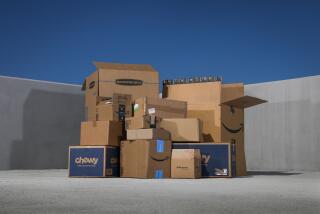Smaller Packaging Makes More Shelf Space in Market, Home : Marketing: The new ‘90s watchwords are smaller is better, even if it’s not cheaper. Capitalizing on environmentalism.
- Share via
NEW YORK — Bigger was better in the 1970s and ‘80s. Savers earned double-digit returns on investments, companies gorged on debt and consumers poured soap powder out of giant-size boxes.
How times change. Now even detergent boxes are smaller.
In a shift toward more frugal thinking, marketers have rolled out a raft of new products in more compact containers--from super-concentrated soaps to slimmer disposable diapers to scrunched-up toilet tissue.
Influenced by the 1990s wave of environmentalism and sluggish economy, consumers now long for less waste--in their personal lives and surroundings.
The lure of smaller packages, which promise to ease pressure on landfills and are easier to carry and store, has even made some shoppers oblivious to the sometimes heftier price tags.
“People don’t want their personal environment polluted with trash,” says Carol Moog, a psychologist and advertising consultant with Creative Focus in Bala Cynwyd, Pa. “It’s a really different mentality.”
Evidence of the new frugality abounds. Consumers seem less willing to accumulate big credit card debts. Companies are slashing hundreds of thousands of jobs to cut costs. Fashion wear is less flashy.
But the trend in the supermarket is a less commonly recognized indicator. Dozens of packages have been downsized or stripped of superfluous layers:
* Tide, Cheer and other super-concentrated powders and liquids in smaller containers now dominate the laundry soap aisle.
* Pampers and Huggies super-slim diapers come in packages that contain 25% less plastic and take up half as much space.
* Underarm deodorants have shed their decorative outside cardboard boxes.
* Ultra-absorbent cat litter in seven-pound plastic jugs is billed as lasting three times longer than the regular 10-pound bag litter.
* Post this year introduced Bran-nola and Banana Nut Crunch in small boxes filled with more cereal than existing boxes up to 30% bigger.
The compact products please supermarkets trying to accommodate an explosion of new brands vying for room on crowded shelves, where three cubic inches is considered valuable real estate.
The trend also has helped companies get the edge in supermarket sections with little potential for further profits or sales. Procter & Gamble Co., for example, says it was able to boost market share with its super-concentrated laundry detergents.
That’s a sharp change from 17 years ago, when Colgate-Palmolive Co. introduced Fresh Start, a super-concentrated powder that sputtered because of limited appeal.
Another plus for manufacturers is cost savings. The cardboard boxes for new concentrated soap powders and the plastic containers, for liquid detergents, use up to 20% less packaging material and weigh 20% less--saving manufacturers about 20% on shipping, handling and packaging costs, said Michael Silverstein, a vice president at Boston Consulting Group in Chicago.
P&G; actually raised the cost per load with the new super-concentrated powder detergents, at least initially. When the detergents were introduced two years ago, consumers paid 9.4% more for each clothes load washed with Ultra Tide with Bleach compared to regular Tide with Bleach, said Andrew Shore, an industry analyst with PaineWebber.
The price increase in powders went mostly to cover P&G;’s investment in research and machinery to create the products, said company spokeswoman Lynn Hailey. She said the company has since cut the prices.
The new liquids were priced between 4% and 9% less per wash load than the regular strength when introduced one year ago, Hailey added.
One reason consumers didn’t seem to mind the higher introductory price is that it’s hard to tell. While the new powders cost slightly less per box, each box handles only 33 loads compared to 36 for the regular. But stores commonly only list the cost per pound or volume of wash loads, not per wash, which is complicated for most consumers to figure out, Silverstein said.
Some manufacturers like to cite environmentalism in introducing concentrated products. But marketing experts say the main motivation is not slashing waste.
Nowadays, about 40,000 items are crammed into big supermarkets, up from 12,000 in smaller stores in the past. With smaller packages, manufacturers can persuade retailers to squeeze more on shelves--resulting in more dollar sales per square foot.
Green marketing is just a nice perk.
“I would say the real motivation is the shelf-space issue,” said Jack Trout of Trout & Ries, a Greenwich, Conn., market strategy firm. “If they can pick up some environmental brownie points while they’re doing it, sure.”
A&M; Products, for example, says its extra-absorbent Scoop Away and Ever Clean cat litters “clump” around liquid waste, allowing cat owners to discard only the offensive portion.
Printed on the jugs is the message that the products result in “less waste than old-fashioned clay litter because you throw out only the clumps. And the less waste you throw out, the less waste goes to landfills.”
Pam Lucchesi, product manager at the Danbury, Conn.-based unit of First Brands Corp., adds that the litter is “easier to use, cuts down on the amount of time you need to maintain the litter box, and in the long run it’s a lot cheaper.”
Nonetheless, retailers say not all the new compact products are getting a strong reception. P&G;’s Charmin Spacemakers, for example, are toilet-paper rolls with tubular inner cores compressed inside the package that expand when removed.
P&G; says an eight-pack occupies the same space as a regular four-pack and fluffs out fully with just a squeeze.
But Margaret McEwan, a spokeswoman for Shaw’s Supermarkets in East Bridgewater, Mass., says consumers may be confused into thinking compressed rolls mean there is a problem with the toilet paper.
More to Read
Inside the business of entertainment
The Wide Shot brings you news, analysis and insights on everything from streaming wars to production — and what it all means for the future.
You may occasionally receive promotional content from the Los Angeles Times.










